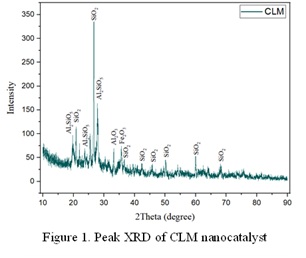Characterization of Lapindo Mud-Based Nanocatalyst and Quality Testing of Biodiesel from Used Cooking Oil via Transesterification Reaction
Abstract
This study explores the transesterification of used cooking oil using a Lapindo mud-based nanocatalyst and evaluates the resulting biodiesel quality. The reaction was carried out via the reflux method for 2 hours at 65°C, with a methanol-to-oil molar ratio of 9:1 and a catalyst-to-oil weight ratio of 3:100. The high SiO₂ metal oxide content in Lapindo mud functions as a heterogeneous catalyst. Nanocatalyst synthesis involved calcination followed by ball milling. Characterization confirmed the presence of SiO₂: FTIR analysis identified Si-O-Si functional groups at 1168 cm⁻¹, XRD revealed SiO₂ crystals at 2θ values of 20.18°, 26.68°, 42.40°, and others, while XRF showed 47.0% SiO₂ content. PSA results indicated a particle size distribution of 514.3 ± 361.8 nm. Biodiesel analysis using GC-MS showed a methyl ester content of 99.26%. Other quality parameters included density (929.4 kg/m³), viscosity (4.52 mm²/s), water content (0.097%), and acid number (0.50 mg-KOH/g). These findings suggest that the Lapindo mud-based nanocatalyst is highly effective in promoting transesterification and presents a promising, eco-friendly alternative for biodiesel production from used cooking oil.
Downloads

Copyright (c) 2025 Rufaidah Zulfa Taqiya, Samik Samik

This work is licensed under a Creative Commons Attribution-NonCommercial-NoDerivatives 4.0 International License.
Authors who publish with this journal agree to the following terms:
- Copyright on any article is retained by the author(s).
- The author grants the journal, the right of first publication with the work simultaneously licensed under a Creative Commons Attribution License that allows others to share the work with an acknowledgment of the work’s authorship and initial publication in this journal.
- Authors are able to enter into separate, additional contractual arrangements for the non-exclusive distribution of the journal’s published version of the work (e.g., post it to an institutional repository or publish it in a book), with an acknowledgment of its initial publication in this journal.
- Authors are permitted and encouraged to post their work online (e.g., in institutional repositories or on their website) prior to and during the submission process, as it can lead to productive exchanges, as well as earlier and greater citation of published work.
- The article and any associated published material is distributed under the Creative Commons Attribution-NonCommercial-NoDerivatives 4.0 International License.





_copy1.png)










